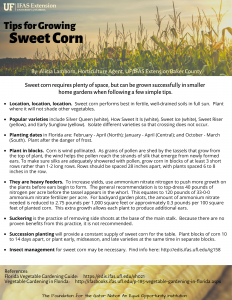When growing sweet corn, many home gardeners have similar questions. Can I plant one long row at the back of my garden to prevent shading other veggies? How much fertilizer do the plants need? Do the suckers need to be removed?
Find the answers to these common questions and more:

References and links:
Florida Vegetable Gardening Guide: https://edis.ifas.ufl.edu/vh021
Vegetable Gardening in Florida: http://ifasbooks.ifas.ufl.edu/p-185-vegetable-gardening-in-florida.aspx
Insect management: http://edis.ifas.ufl.edu/ig158
 0
0
